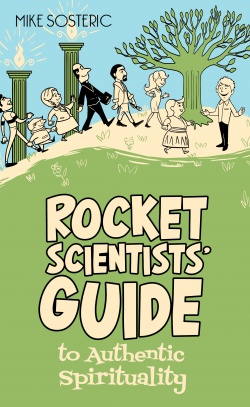Authentic Spirituality: Difference between revisions
An Avatar.Global Resource
No edit summary |
No edit summary |
||
| Line 2: | Line 2: | ||
<h1 class="customtitle">{{FULLPAGENAME}}</h1> | <h1 class="customtitle">{{FULLPAGENAME}}</h1> | ||
<blockquote class="definition"> | <blockquote class="definition"> | ||
'''Authentic Spirituality''' is spirituality that encourages, supports, and facilitates [[Healing]] and [[Connection|Connection]]. As outlined in the ''Rocket Scientists' Guide to Authentic Spirituality'', you can recognize an authentic spirituality by the presence of all [[Seven Pillars of Authentic Spirituality<ref>Sosteric. Rocket Scientists’ Guide to Authentic Spirituality. St. Albert, Alberta: Lightning Path Press.</ref> | '''Authentic Spirituality''' is spirituality that encourages, supports, and facilitates [[Healing]] and [[Connection|Connection]]. As outlined in the ''Rocket Scientists' Guide to Authentic Spirituality'', you can recognize an authentic spirituality by the presence of all [[Seven Pillars of Authentic Spirituality]]<ref>Sosteric. Rocket Scientists’ Guide to Authentic Spirituality. St. Albert, Alberta: Lightning Path Press.</ref> | ||
</blockquote> | </blockquote> | ||
Revision as of 16:15, 9 October 2020
Authentic Spirituality
Authentic Spirituality is spirituality that encourages, supports, and facilitates Healing and Connection. As outlined in the Rocket Scientists' Guide to Authentic Spirituality, you can recognize an authentic spirituality by the presence of all Seven Pillars of Authentic Spirituality[1]
Related Terms
Authentic Spirituality > Authentic Institution, Religion
Syncretic Terms
Authentic Spirituality > Avatar.GLOBAL Knowledge System, Cosmic Religion, Identity Consistent Spirituality, Mysticism, Perennial Philosophy, Positive Religion, Progressive Spirituality, Pure Religion, Right Path, The Path, The Way, True Path
Notes

"True religion, then, is not necessarily what goes on in the name of religion. Institutionalized religion is often a mistranslation of higher truths experienced by the truly religious, the founders of various religions. Religion in its basic connotation is a means of experiencing a higher level of consciousness. Religion, therefore, may not be considered as a body of sacred truths, but rather a method or a set of practices believed to achieve a state of awareness and feelings that takes us beyond the normal states of awareness and being, and to stand in a special relationship to something considered divine."[2]
Stanislav Grof says
Authentic spiritual systems are based on ... systematic exploration of the psyche using well-defined mind-altering technologies. They are results of a process that in many ways resembles the scientific method.[3]
Authentic religion is religion that "nurtures people's relationship with whatever they hold sacred."[4]
Leo Tolstoy's The Kingdom of God is Within You[5] provides an extended discussion of the difference between an authentic understanding of Christ's teachings, and an unaligned, hypocritical, an inauthentic reading used to justify the status quo, rather than emancipate humanity, as Christ had intended. As with Einstein, Tolstoy felt that an authentic spirituality provided a ready-made solution to humanity's ills. It "solves all the contradictions and all his sufferings."
Authentic spirituality makes a difference, not within the extended time frames of Old World Spirituality(i.e. years, decades, and lifetimes), but within short, workable, and verifiable time frames of days, weeks, and months. In other words, techniques and principles provided by an authentic spirituality will have an immediate and discernible positive impact.
Wicca and Pagan Spiritualities
Wicca and pagan religions are an attempt to develop/reclaim an authenticity lost in traditional mainstream elite exoteric religion. "The Pagan vision is one which says that neither doctrine nor dogma nor asceticism nor rule by masters is necessary for the visionary experience, and that ecstasy and freedom are both possible." [6]
"A common phrase you hear is "I've come home," or, as one woman told me excitedly after a lecture, "I always knew I had a religion, I just never knew it had a name." [7]
Margot Adler's discovery of wicca was the culmination of a search for authenticity, a "ecological-religious framework compatible with my own politics and commitment to the world."[8] Adler had a Connection Experience whereafter listening to a tape of some Wiccan rituals. "A feeling of power and emotion came over me." (p. 20).
Non repressive, general. "Many people said that they become Pagans because they could be themselves and act as they chose, without what they felt were medieval notions of sin and guilt." [9]
Non repressive, feminism. A spirituality that honoured women, outside of the patriarchal mainstream. [10]
Citation and Legal
Treat the SpiritWiki as an open-access online monograph or structured textbook. You may freely use information in the SpiritWiki; however, attribution, citation, and/or direct linking are ethically required.
Footnotes
- ↑ Sosteric. Rocket Scientists’ Guide to Authentic Spirituality. St. Albert, Alberta: Lightning Path Press.
- ↑ Ramakrishna, K. Rao. “Some Reflections on Religion and Anomalies of Consciousness.” In Body, Mind, Spirit, 68–82. Charlottseville, VA: Hampton Roads, 1997. p. 71
- ↑ Laszlo, Ervin, Stanislav Grof, and Peter Russell. The Consciousness Revolution. Las Vegas: Elf Rock Productions, 1999. pp. 38.
- ↑ Mahoney, Annette, and Kenneth I. Pargament. “Sacred Changes: Spiritual Conversion and Transformation.” Journal of Clinical Psychology, no. 5 (2004): 481-2.
- ↑ Tolstoy, Leo. The Kingdom of God Is Within You (Classics To Go) EBook: Leo Tolstoy: Amazon.ca: Gateway. Translated by Constance Garnett. CreateSpace, 2016. https://amzn.to/2Dg2jtj
- ↑ Adler, Margot. Drawing Down the Moon: Witches, Druids, Goddess-Worshippers, and Other Pagans in America Today. Boston: Beacon Press, 1986. p. xii.
- ↑ Adler, Margot. Drawing Down the Moon: Witches, Druids, Goddess-Worshippers, and Other Pagans in America Today. Boston: Beacon Press, 1986. p. 14.
- ↑ Adler, Margot. Drawing Down the Moon: Witches, Druids, Goddess-Worshippers, and Other Pagans in America Today. Boston: Beacon Press, 1986. p. 19-20.
- ↑ Adler, Margot. Drawing Down the Moon: Witches, Druids, Goddess-Worshippers, and Other Pagans in America Today. Boston: Beacon Press, 1986. p. 23.
- ↑ Adler, Margot. Drawing Down the Moon: Witches, Druids, Goddess-Worshippers, and Other Pagans in America Today. Boston: Beacon Press, 1986. p. 23.
